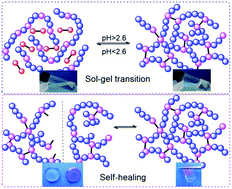pH-Switchable and self-healable hydrogels based on ketone type acylhydrazone dynamic covalent bonds†
Abstract
Stimuli-responsive hydrogels using dynamic covalent bonds (DCBs) as cross-links may exhibit simultaneously the stimuli-responsibility of the physical gels and stability of the chemical gels. We prepared well-defined, ketone-based polymers based on commercially available diacetone acrylamide (DAAM) by a reversible addition–fragmentation chain transfer (RAFT) polymerization technique. The polymers could react with hexanedihydrazide yielding hydrogels. The mechanics, flexible properties and gelator concentration of the hydrogels can be tuned by varying the ratio of DAAM. Gelation time and hydrogel stability were gravely affected by the pH of the surrounding medium. The hydrogels possess self-healing ability without any external stimuli and undergo switchable sol–gel transition by the alternation of pH. In addition, the hydrogels showed pH-responsive controlled release behavior for rhodamine B. These kinds of ketone-type acylhydrazone DCB hydrogels, avoiding the aldehyde component, may ameliorate their biocompatibility and find potential applications in biomedicines, tissue engineering, etc.



 Please wait while we load your content...
Please wait while we load your content...